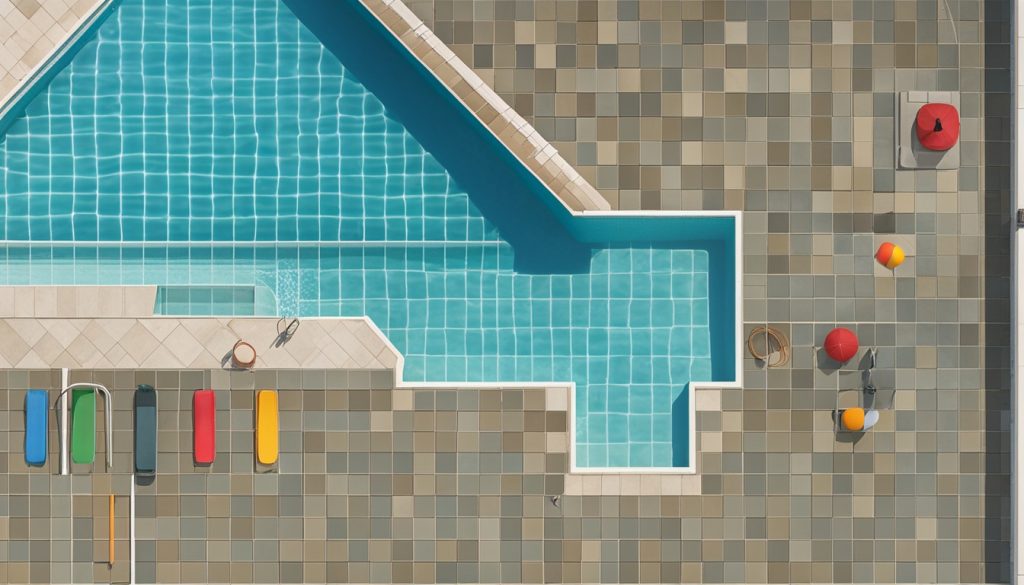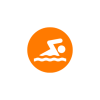Planning the depth of a swimming pool is crucial. It affects the pool’s design, how it works, and how safe it is. Different activities need certain depths for comfort and safety. For instance, diving athletes need a pool that’s at least 5 metres deep.
For water polo or artistic swimming, there are specific depth rules for competitions. Also, pools must meet standards set by groups like World Aquatics. Olympic pools must be at least 1.35 metres deep, but can be deeper for certain events. This ensures they follow swimming pool construction guidelines.
Pool depths aren’t just for competitions. Leisure pools have different depths for relaxing and having fun. Good planning means we can make pools that are useful for many things. This makes the money spent on them more valuable.
Key Takeaways
- Accurate depth planning is essential for safety and functionality.
- Olympic pools require a minimum depth of 1.35 metres for compliance.
- Leisure pools typically range from 0.5 to 2.5 metres in depth.
- Diving pools need at least 5 metres for high dives.
- Incorporating features like spas can enhance property value and appeal.
- Understanding depth requirements can optimise user experience.
- Depth planning influences overall pool design and purpose.
Understanding Pool Depth Considerations
Choosing the right pool depth is key for safety and fun. We need to match the depth with the pool’s use. This ensures everyone has a safe and fun time.
The Importance of Correct Pool Depth
Having the right pool depth keeps everyone safe, from experts to beginners. Pools for families should be at least three feet deep. This lets both kids and adults swim comfortably.
For sports like basketball and volleyball, a depth of 3.5 to 4 feet is best. Lap swimmers need a depth of five feet for safety and comfort during intense swimming.
Following safety standards is crucial to prevent drowning. Pools for toddlers should start at two feet deep, increasing to three feet as kids get better at swimming. Diving areas must be at least ten feet deep to avoid injuries. This shows how important accurate depth planning is in designing pools.
Factors Influencing Pool Depth Decisions
Many factors affect how deep we make a pool. We must think about the pool’s main use, whether it’s for fun or competition. Having different depths lets people enjoy various activities.
A typical pool might have shallow ends at 3.5 feet and deeper areas in the middle for serious swimming. This design suits both casual and competitive swimmers.
We should consider the heights and swimming skills of those using the pool. A tall husband and a shorter wife might need different depths for safety. Pools for relaxing should be three to four feet deep, but deeper pools mean more upkeep, so planning is key.
For more on pool construction and best practices in depth planning, check out this resource.
Planning the Depth of the Pool: Best Practices
When planning the depth of our swimming pool, we must think about what the users need. The depth affects the pool’s design and how it works. It’s important to follow guidelines to ensure the pool is both fun and safe.
Depth Requirements for Different Activities
A family of six to eight needs a pool that’s about 4m by 8m, with depths under six feet. This size is great for fun swimming. For smaller families, a 3m by 6m pool is enough for swimming and chilling out. Rectangular pools are best for different activities.
For those who exercise, a pool that’s at least 10m long is good, with a depth of about 2m. Swimmers who compete do well in pools that are 12 to 15m long. They can practice their strokes properly. Serious swimmers should look for depths from 1.5m, following SPATA’s advice.
For diving, the pool’s depth is key. Diving pools need to be 3 to 5.8m deep, based on the board’s height. It’s important to plan the depth well for safety and fun in all activities.
Safety Standards and Regulations
Knowing the rules about pool depth is key for safety and following the law. Commercial pools must meet certain depth standards. Pools for competitions also have specific depth rules set by groups like World Aquatics.
It’s vital to have safety features like signs and barriers around the pool, especially for kids. Following local codes helps manage risks and makes the pool safer. Not following these rules can lead to big problems and waste our pool investment.

| Pool Type | Recommended Size | Depth Requirements | Activities |
|---|---|---|---|
| Recreational Pool | 4m x 8m | Up to 6 feet | Family activities |
| Small Family Pool | 3m x 6m | Up to 6 feet | Swimming and relaxation |
| Lap Pool | 10m or more | 2m | Exercise and training |
| Competitive Pool | 12m – 15m | Minimum 1.5m | Professional practice |
| Diving Pool | Varied | 3m – 5.8m | Diving |
Conclusion
Planning is key when figuring out the best pool depth. We must consider design, safety, and construction guidelines. This ensures our pool is safe and fun for everyone. Additionally, it’s important to evaluate the intended use of the pool, whether for recreational activities, relaxation, or exercise. Size and shape considerations for pools can significantly influence the overall experience, as they dictate how the space will be utilized. By accounting for these factors, we can create a pool environment that meets everyone’s needs while promoting a safe and enjoyable atmosphere. Additionally, understanding pool construction techniques and tips can greatly enhance the overall experience and longevity of the pool. By incorporating the right materials and methods, we can achieve not only aesthetic appeal but also durability and safety. Ultimately, careful planning and execution will lead to a successful pool that everyone can enjoy for years to come.
Choosing the right depth depends on the pool’s purpose. Whether it’s for swimming or diving, this choice is crucial. Talking to experts in pool building helps us find the perfect depth and shape.
When thinking about changes or big updates, it’s important to work with professionals. They help us make a pool that’s safe, enjoyable, and saves resources. For detailed advice on building an Olympic swimming pool, check out Fluidra’s resources. They offer valuable insights on pool planning and design.
FAQ
What is the optimal depth for a diving pool?
The best depth for a diving pool is usually between 3 to 5.8 metres. This depends on the diving board’s height. It makes sure diving is safe and reduces injury risks.
How does pool depth impact safety?
Pool depth is key to safety, especially for diving and swimming. Deeper pools lower injury and drowning risks, especially for kids and new swimmers. Following the right depth rules is vital for safety.
What regulations must be followed when planning pool depth?
You must follow local and international rules when setting pool depth. For competitive pools, World Aquatics has specific rules for safety and event compliance.
How can I determine the appropriate depth for leisure pools?
For fun pools, start with a shallow end of about 0.5 metres. Then, go up to a deeper end of 2.5 metres. This setup is great for family fun and various swimming activities.
What are the best practices for planning pool depth?
Good practices include knowing the pool’s use, following safety rules, and getting expert advice. Working with skilled pool builders can offer custom advice for your needs.
Why is accurate depth calculation important?
Getting the pool depth right is crucial for safety and function. It helps avoid accidents and makes swimming safer. It also makes the pool more enjoyable for everyone.
